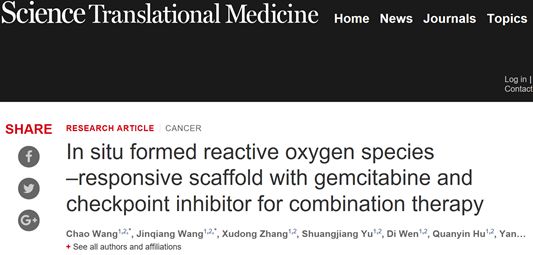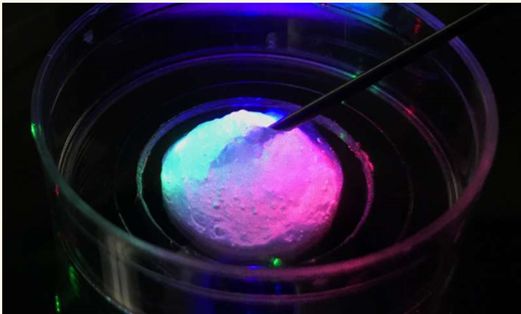New gameplay! Gel-like stent anti-cancer new therapy!
Release date: 2018-03-05
Scientists at the University of North Carolina School of Medicine and North Carolina State University have created an injectable gel-like scaffold that can hold chemotherapy immunotherapy drugs and deliver them locally to the tumor in sequence. The study, published in "Science Translational Medicine," focuses on the treatment of two specific types of melanoma and breast cancer, but this method can be applied to other tissue types. In addition, studies have shown that this topical delivery combination therapy significantly inhibits the recurrence of cancer after surgical resection of primary tumors.

In our bodies, normal cells mutate from their typical forms and functions. Fortunately, as our immune system moves normal cells and performs important biological functions, the mutant cells are identified and destroyed. Unfortunately, these units can hijack systems that are dedicated to dispatching them. If this happens, these cancer cells are almost undetectable, free to multiply, and capable of forming tumors.

Blocking tumor tissue with gel combined with chemotherapy drugs
Immunotherapy attempts to reset our immune response to identify these "hijacking" cancer cells. For example, immunological checkpoint block (ICB) therapy targets a cellular pathway that modifies cell death; this therapy triggers this pathway so that cancer cells are killed. This therapy has shown incredible potential for the treatment of various forms of cancer, such as melanoma, kidney cancer, head and neck cancer, bladder cancer, and non-small cell lung cancer.
But it can have troublesome side effects, including starting the immune system to attack healthy tissue. Often this immunotherapy does not work because many tumors lack the specific features that immunotherapy recognizes and attacks cancer cells as enemies. These tumors are called low immunogenic tumors.
If you first attack the tumor with chemotherapy, then doctors can get better results through immunotherapy. However, this method is still insufficient for patients with low immunogenic tumors. Therefore, scientists have been designing methods to make immunotherapy more effective.

To this end, researchers at UNC and NC have developed what they call bioreactive stent systems. Essentially, it is a hydrogel - a polymeric scaffold that can be loaded with a therapeutic drug.
“Once the biocompatible polymer is mixed with its crosslinker, it can form a gel quickly in the body,†said Jinqiang Wang, a lead author and laboratory postdoctoral researcher. “We are convinced that one of these drugs can be activated by reactive oxygen species. Or ROS apart."
In the context of cancer, high levels of ROS are major players in tumor development and growth. The researchers loaded the chemotherapy gemcitabine and the immunotherapeutic agent, the anti-PD-L1 blocking antibody, onto the hydrogel scaffold. When injected into a tumor, the gel promotes tumor features that are identifiable by immunotherapy. Then, in response to high levels of ROS in the tumor, the scaffold gradually decomposes, first releasing gemcitabine and then releasing anti-PD-L1.
"Cytotoxic chemotherapy can kill some cancer cells first and increase the sensitivity of the tumor to ICB treatment, thereby stimulating the effectiveness of ICB treatment," said co-author Dr. Gianpietro Dotti. "As the gel degrades, the ROS levels in the tumor site Can be reduced, which also helps to inhibit tumor growth."
UNC / NC state scientists tested this therapeutic gel-mediated approach to two cancers - B16F10 melanoma and 4T1 breast cancer, which are less immunogenic. This method effectively makes the tumor microenvironment easy to treat. When the payload is released, the tumor is significantly reduced. The researchers then performed experiments to form a hydrogel scaffold at the surgical site after removal of the primary tumor. They witnessed a significant inhibition of cancer recurrence by gel scaffolds.
"With regard to the potential of this approach, scientists should further investigate the biocompatibility of using gel scaffolds for clinical benefit," Gu said. "At the same time, we will optimize the dose and frequency of treatment."
references:
Chao Wang, Jinqiang Wang, Xudong Zhang, Shuangjiang Yu. In situ formed reactive oxygen species–responsive scaffold with gemcitabine and checkpoint inhibitor for combination therapy.
Source: Translational Medicine Network
Water Soluble Powder/Powder,Albendazole And Ivermectin Powder,Doxycycline Hyclate Soluble Powder,Pulsatilla Chinensis
Sichuan Aibang Weiye Biological Engineering Co., Ltd. , https://www.aibangpharm.com